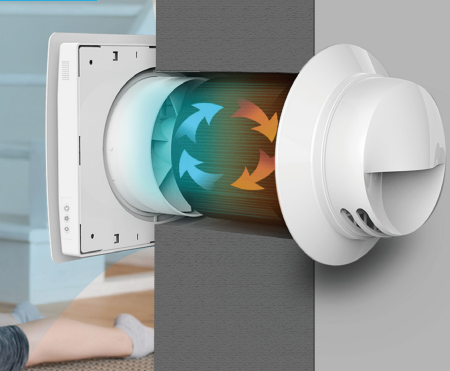How Long Does HRV Perform? Understanding System Lifespan
Wiki Article
The All-Inclusive Guide to the Uses of Heat Recovery Ventilation in Modern Structures
Heat Recovery Ventilation (HRV) systems represent a considerable innovation in building modern technology (HRV Heat Recovery Ventilation). They provide an approach for exchanging stale interior air with fresh outdoor air while decreasing power loss. This strategy not just enhances interior air quality however also contributes to power efficiency in both household and industrial buildings. Comprehending the numerous applications and benefits of HRV can expose its crucial role in contemporary style and sustainability efforts. The ramifications of this innovation are worth discovering even moreComprehending Heat Recovery Ventilation Equipments

Although many modern buildings prioritize power effectiveness, recognizing warm healing ventilation (HRV) systems is vital for enhancing interior air top quality and decreasing energy usage. HRV systems work by transferring heat from stale indoor air to incoming fresh air, efficiently keeping comfy interior temperatures while reducing power loss. These systems include a warm exchanger, fans, and ductwork that facilitate the flow of air. During winter months, HRV units record and reuse warmth from the outgoing air, while in summertime, they can assist cool inbound air. By continually trading air, HRV systems likewise lower humidity and the focus of interior toxins. Proper installment and maintenance of HRV systems are vital for their performance and performance in boosting overall structure efficiency and convenience.
Benefits of Heat Recovery Ventilation
Heat recovery ventilation systems use numerous advantages that enhance both energy performance and interior air quality in modern-day structures. By capturing and reusing energy from exhaust air, these systems significantly lower home heating and air conditioning expenses, resulting in reduced energy consumption. In addition, they preserve a constant flow of fresh outdoor air, decreasing the risk of interior air pollutants and allergens. This continual exchange helps control humidity levels, preventing mold and mildew development and guaranteeing a healthier living setting. In addition, HRV systems contribute to sustainability goals by lowering total carbon footprints. Their capability to enhance air flow without giving up thermal convenience makes them a useful enhancement to modern building design, promoting both economic and environmental benefits.Applications of HRV in Residential Structures
As property owners significantly prioritize energy effectiveness and interior air top quality, the applications of warm recuperation ventilation (HRV) systems in domestic buildings have ended up being much more common. HRV systems are particularly helpful in tightly sealed homes, where preserving fresh air circulation is crucial for preventing wetness accumulation and interior toxins. They properly move warmth from outgoing stale air to incoming fresh air, reducing energy costs related to home heating and air conditioning. In addition, HRVs can enhance convenience degrees by controling humidity and temperature level. They are likewise adaptable for different property styles, consisting of single-family homes and multi-unit buildings. On the whole, sites incorporating HRV systems sustains lasting living practices while ensuring a healthier interior environment for occupants.HRV in Industrial and Industrial Settings
In commercial and commercial settings, the application of warmth recuperation ventilation (HRV) systems has actually come to be increasingly critical for enhancing energy effectiveness and preserving air high quality. These systems successfully move warm from exhaust air to incoming fresh air, minimizing the demand for extra home heating or cooling. This not just decreases energy expenses yet also contributes to sustainability campaigns. Industries such as manufacturing, warehousing, and workplace structures profit substantially from HRV systems, as they assist regulate temperature and humidity degrees, making sure a comfortable and efficient setting. Moreover, HRV systems help in getting rid of contaminants and excess dampness, enhancing indoor air high quality. As guidelines around air high quality end up being stricter, the fostering of HRV modern technology is most likely to grow, making it an essential part of modern-day commercial and industrial facilities.Future Trends in Heat Recovery Ventilation Innovation

Regularly Asked Concerns
Just How Does Heat Recovery Ventilation Influence Indoor Air Quality?
Heat recovery ventilation greatly boosts interior air top quality by constantly exchanging stagnant indoor air with fresh outdoor air while recouping power. This procedure minimizes pollutants, maintains excellent humidity degrees, and guarantees a healthier environment for occupants.Can HRV Equipments Be Installed in Existing Buildings?
HRV systems can without a doubt be mounted in existing buildings. Retrofitting may require modifications to ductwork and ventilation designs, yet it substantially enhances power efficiency and indoor air top quality, making it a sensible choice for index older frameworks.What Maintenance Is Needed for HRV Equipments?

Are There Certain Climates Where HRV Is A Lot More Effective?
Heat recovery ventilation systems are particularly effective in environments with considerable temperature level differences in between seasons. These systems enhance power efficiency by recovering warm from exhaust air, making them optimal for both chilly and moderately cozy settings.Just How Do HRV Solutions Affect Energy Costs?

Report this wiki page